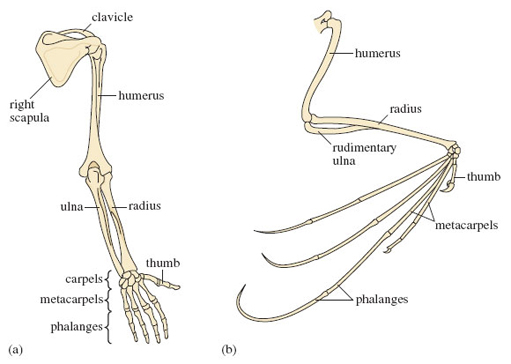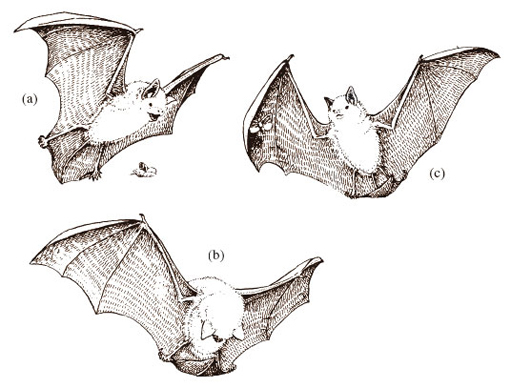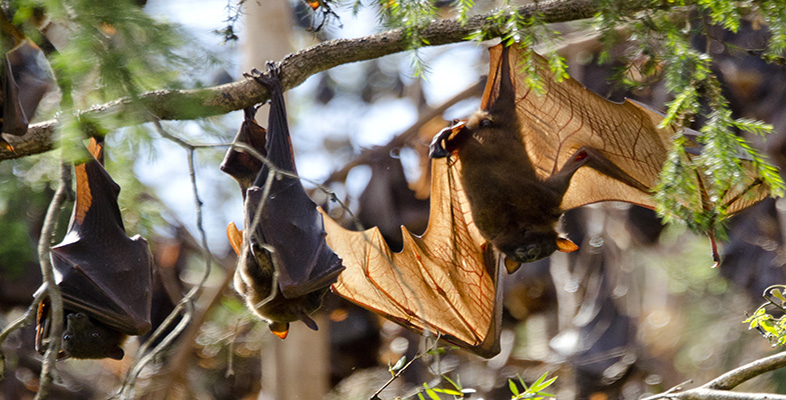3.5 Bats
There are two more activities in this section that give you more practice in writing. You will see that you are again given an approximate number of words to aim for in your answer. This number is a guide to the level of detail required - you will often find the same thing done in course assessment questions. Write your answer as concisely as you can, checking that you have not repeated any points, and then count the words. If you have written more than the suggested number, do not spend time going through your work again, cutting out the odd word here and there; that is not necessary at this stage, but do compare your answer with the one given, and try to identify where you could have cut down.
From LoM you'll know of the spectacular adaptations in bats (order Chiroptera) that relate to hunting and catching insects in flight. The major adaptations of bats that you read about are, of course, the development of wings and the structures linked to the production and detection of ultrasonic sounds. The bat wing is a modified mammalian forelimb, in which over evolutionary time, the bones have become considerably lighter and certain bones have undergone great elongation. It's revealing to compare a less highly modified forelimb from a human (Figure 4a) with that of a bat (Figure 4b). The bat's finger bones - metacarpals and phalanges - are long and thin. The ulna is greatly reduced, almost completely lost. The clawed thumb remains free and is used for moving around roosts. You'll notice that the bones within the human and bat forelimb are identically named. This is because they are homologous, i.e. they were derived from an equivalent structure in the ancient common ancestor of these two species. By contrast, the wings of bats and insects, though they share the same function, did not originate from the limb of a common ancestor; insect wings are extensions of the outer covering of the body, the cuticle. Thus insects and bat wings are termed analogous, i.e. identical function but without a common evolutionary origin.

The concepts of homology and analogy were central to comparative biology from their invention early in the 19th century until very recently. These long established principles were challenged in the 1990s by the discovery that similar, in some cases identical, genes direct the development of eyes, legs, wings and other structures in animals as different as insects and mammals. The results of this very active field of current research are already prompting a fundamental revision of our thinking about homologous and analogous structures.
DA describes the bat's wing as an extension of the skin 'from the side of the neck across the fingers and down to the leg' [p. 45]. Some species have a tail membrane too, which extends between the two hindlimbs; Daubenton's bat (Figure 5) is one such species. The wing and tail membrane is a living tissue, comprising brown or black (and almost hairless) skin that has considerable elasticity. The wings are flexible, but are held relatively stiffly (i.e. under tension) during flight by the arrangement and action of those muscles of the bat devoted to flight.

Activity 5
Reread the part of LoM that explains how bats use ultrasonic sound as a navigational system and as a means of locating their insect prey during night flying [pp. 45-46]. Watch the sequence on bats from the TV programme, from 28.50-39.38, and jot down notes on how bats detect and catch insects. Explain, in up to 200 words in total, (a) how bats generate focused beams of ultrasonic sounds, and (b) how they use the sounds for navigation and locating prey (flying insects).
Discussion
(a) While flying, bats generate short bursts of ultrasonic sound with the larynx in their throat, emit them via the nose and mouth and listen to the echoes of the sounds as they bounce back from objects in the area. The beam of sounds is focused by means of a nose leaf in many bats. The shape of the nose leaf varies according to species, and includes bowls, slits and other shapes. The nose leaf may be mobile, enabling the bat to vary the width of the beam that is projected.
(b) The time taken for the echo to return to the bat varies with the distance from each object and whether it is moving or not. The type of echo received also gives a clue as to the nature of the object. So as the bat scans its surroundings during flight, it is able to identify flying insects. As the bat closes in on its prey, the 'short stabs' of ultrasonic calls become more frequent.
The human ear cannot detect these ultrasonic sounds, but researchers use bat detectors to track bats in flight. One type of detector picks up bat calls by an ultrasonic microphone and converts the sounds into sonic frequencies that are audible to the human ear. The output of a bat detector is, therefore, not an exact reproduction of the original bat call. Nevertheless, the patterns of sounds are reproduced, and are typical for each species, and also for the activity of the bat. Bat detectors have been used to look at feeding in Daubenton's bats, which featured in the TV programme. When these bats approach their prey, they emit intense bursts of sound, 'feeding buzzes', used for locating the insect's exact position.
Activity 6
Look back at the notes you made for Activity 5, above, and use them to write a brief description, in up to 150 words, of the prey-capture techniques used by bats featured in the TV programme from 28.50-39.38.
Discussion
Bats, of course, use the mouth, and in particular the teeth, for capturing prey but also, more surprisingly, the wings, which, as I've already mentioned, are very flexible. Variations of hunting strategies are seen in different species. Daubenton's bats fly close to the surface of a stream, grabbing flying insects with their mouth or feet and using the tail membrane as a catching basket (Figure 5b). The bat bends its head towards the scoop made by the tail membrane and picks up the insect with its teeth. Long-eared bats fly amongst branches of trees, and detect moths by listening for the sounds they make in flight or when eating; they use their teeth to pick up insects from a leaf, cupping the wings over the prey to prevent its escape.
